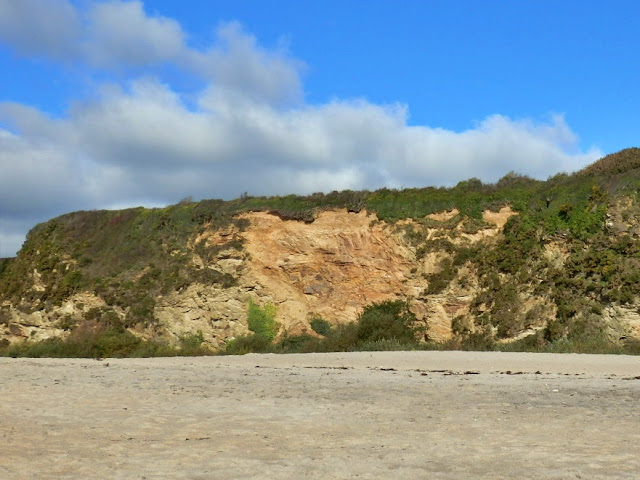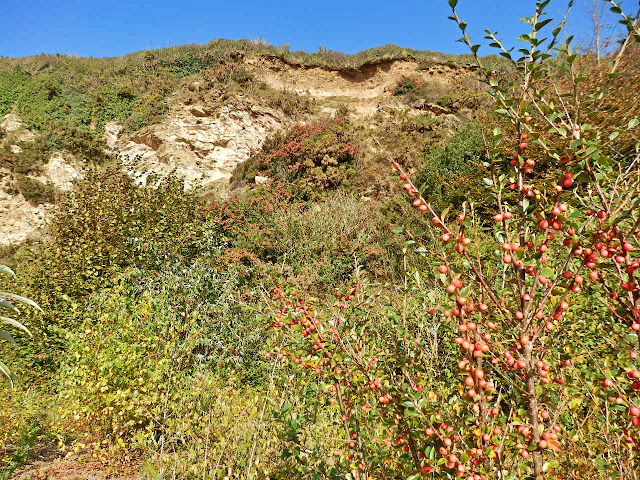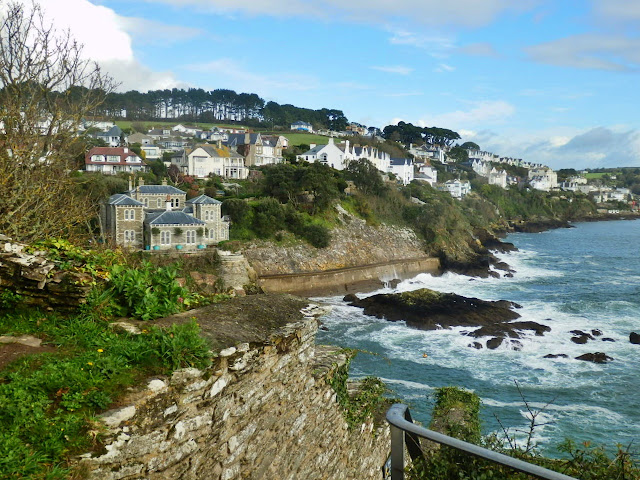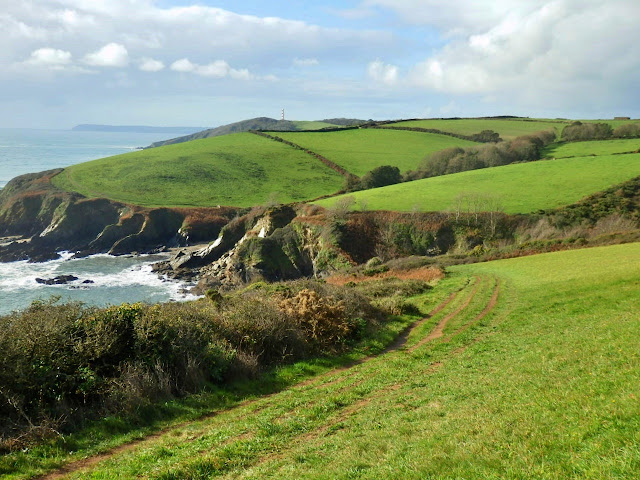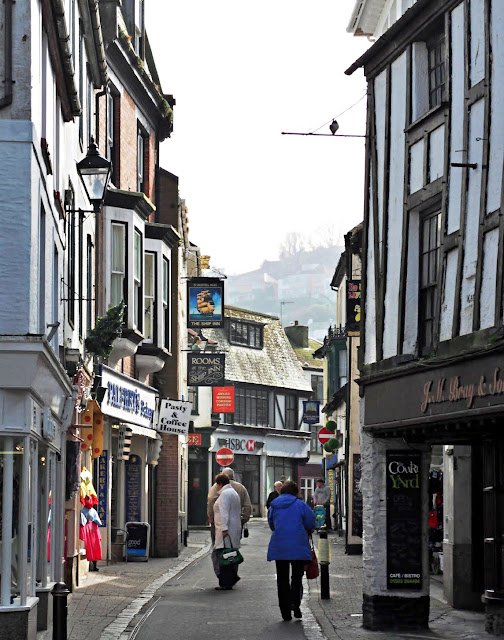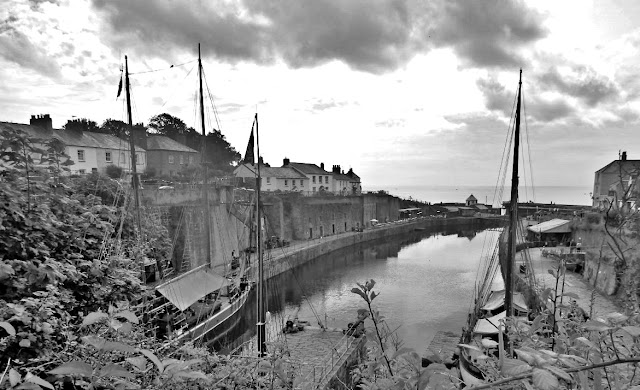Saturday 26 October 2019
Carlyon Bay, Cornwall: Sand, Sea and Cliffs
It had been a rough morning weather-wise. When the rain stopped we decided to have a quick walk along the beach at Carlyon Bay to blow the cobwebs away.
The sky gradually improved so I snapped a few quick photos - nothing too special. Not like the time we had a meeting with barrel jellyfish.
Not many people about. The rusty looking fence, to the left of the photo above, is part of the supposed redevelopment of Carlyon Bay. There are plans to build a beachside village here - but this has been said for many, many years. Details of the proposed development can be seen here. I'll believe it when I see it!
At the back of the beach are cliffs - it's quite pleasant walking along the coastal path at the top of the cliffs.
As the weather had been a bit rough there was a line of seaweed and shells on the seashore.
I was hoping to find treasure rather than sea shells - but, as usual - we took a few shells home.
The photo below may seem a bit strange but a river of water runs across the beach from the cliffs and cuts its own path across the sand. Somehow any developers would have to solve this problem.
Another view of the cliffs. Oh, and if you walk to the far end of the beach in the summer months beware of nudists!
Wednesday 23 October 2019
Walking From Ready Money Cove, Fowey to Gribbin Head, Cornwall
Today's post continues walking from St. Catherine's Castle, near Ready Money Cove, Fowey towards Gribbin Head - shown in the photo above.
On leaving the castle I looked back at Dawn French's £3,000,000 mansion on the cliffs at Ready Money cove - to the left of the photo. For overseas readers Dawn is a well known actress, writer, comedian and presenter in the UK. A lovely spot to have a house.
The Fowey River is also in view.
I passed through Covington Woods without realising I had done so.
The initial coastal path is along the cliff tops. A strange thing is that, on my complete walk, I only saw two other people - which was quite nice!
There are a few coves on the route to scramble down if so inclined.
Otherwise the coastal path continues with quite a few ups and downs. The cove shown is Coombe Haven.
Part of the coastal path is looked after by the National Trust.
The countryside changes with green fields, at their best because of all the recent rain.
Gribbin Head comes into view. The red and white striped daymark can just be seen, on the skyline, towards the right of the photo below.
The path continues along the cliff tops to Gribbin Head and some of my favourite countryside.
The final hill to Gribbin Head.
Of course walking such a path normally means having to either retrace your steps back to the start, or having someone pick you up at your destination. Whatever, it's a lovely walk.
Sunday 20 October 2019
St. Catherine's Castle, near Ready Money Cove, Fowey, Cornwall
I had a free morning and decided to head for St.Catherine's castle high on the cliffs next to Ready Money Cove, Fowey.
As can be seen in the black and white photo above the castle is partly a ruin.
I parked my car in a side road and walked along the Esplanade towards Ready Money Cove. The castle can just be seen in the photo below.
I reached Ready Money Cove. The tide was out and all was peaceful. Hard to believe it gets so packed with visitors during the summer season.
There is a set of steps from the beach, which heads up to a coastal path. The climb is quite steep. The path was quite muddy.
While climbing the path there are some great views of Ready Money Cove and ...
… the Fowey River.
And finally St. Catherine's Castle is reached. There is a sign (entrance is free) which reads:
The tower's heavy guns protected Fowey harbour from enemy ships. Walls with musket loopholes are later additions. In 1855 two heavy guns were installed in circular positions below the tower.
Below shows one of the heavy gun positions mentioned above.
The next photo illustrates how the castle was positioned to protect the entrance to the Fowey River. On the opposite side of the river is Polruan.
There are a few steps to climb to reach the inside of the tower itself.
A couple of musket loopholes.
Leaving the tower there are views along the Fowey River.
A warning sign about the 'steep drops'.
Looking across from the castle to Polruan another small castle, known as a Blockhouse, can be seen on the water's edge. This was erected in the 15th century, again for the defence of the Fowey River.
It was linked by a large chain with a similar Blockhouse on the Fowey side of the river. The chain could be raised to stop unwanted ships entering the harbour - and was last used way back in 1666.
That concludes my visit to St.Catherine's Castle - but first a quick note about car parking.
The car parks in Fowey can quite expensive, but at this time of year (October to April) I park on roads where there are single yellow lines. See sign below which verifies this is okay. Always double check the signs though.
And a final note. Driving into Fowey there is a right turn and then markings which tend to lead you into a carpark. Ignore these (between October and April) and head straight along the road where there are some lovely views - as the early morning photo below.
As can be seen in the black and white photo above the castle is partly a ruin.
I parked my car in a side road and walked along the Esplanade towards Ready Money Cove. The castle can just be seen in the photo below.
I reached Ready Money Cove. The tide was out and all was peaceful. Hard to believe it gets so packed with visitors during the summer season.
There is a set of steps from the beach, which heads up to a coastal path. The climb is quite steep. The path was quite muddy.
While climbing the path there are some great views of Ready Money Cove and ...
… the Fowey River.
And finally St. Catherine's Castle is reached. There is a sign (entrance is free) which reads:
ST. CATHERINE'S CASTLE
KASTEL S. KATTRIN (Cornish language)
A gun tower built 1538-40 by Thomas Treffry for Henry VIII (reigned 1509-47) as part of a national defence programme.
The tower's heavy guns protected Fowey harbour from enemy ships. Walls with musket loopholes are later additions. In 1855 two heavy guns were installed in circular positions below the tower.
Below shows one of the heavy gun positions mentioned above.
The next photo illustrates how the castle was positioned to protect the entrance to the Fowey River. On the opposite side of the river is Polruan.
There are a few steps to climb to reach the inside of the tower itself.
A couple of musket loopholes.
Leaving the tower there are views along the Fowey River.
A warning sign about the 'steep drops'.
Looking across from the castle to Polruan another small castle, known as a Blockhouse, can be seen on the water's edge. This was erected in the 15th century, again for the defence of the Fowey River.
It was linked by a large chain with a similar Blockhouse on the Fowey side of the river. The chain could be raised to stop unwanted ships entering the harbour - and was last used way back in 1666.
That concludes my visit to St.Catherine's Castle - but first a quick note about car parking.
The car parks in Fowey can quite expensive, but at this time of year (October to April) I park on roads where there are single yellow lines. See sign below which verifies this is okay. Always double check the signs though.
And a final note. Driving into Fowey there is a right turn and then markings which tend to lead you into a carpark. Ignore these (between October and April) and head straight along the road where there are some lovely views - as the early morning photo below.
Thursday 17 October 2019
Looe Town, River and Beach
A few photos today of Looe, which follows on from my previous post Looe Island and St. Michael of Lammana Chapel.
Above is the River Looe with the attractive bridge in the background. The first proper bridge is thought to have been erected in 1411 and was made of wood. The present stone bridge, with its seven arches, was opened in 1853.
Walking alongside the river is very pleasant. The seagulls appreciate it's beauty - and any chips dropped by passers by!
The town of Looe is known for its narrow streets. Luckily the street below is one way only!
There's a restaurant tucked away, along with several others. The photos were taken out of the summer season, otherwise the streets would be heaving with tourists.
Walk through Looe town and you will soon reach the beach - again this is very popular in the summer season.
When walking back through the town I was telling my wife about memories of London, when young, and how I'd go to a special café for coffee and rumbabas - and how I hadn't seen any in shops for many years.
By coincidence we then passed a bakers, and what was in the window? Rumbabas! So a purchase was made.
There is a small station at Looe. about five or ten minutes from the bridge. You can see a local train in the photo below.
The The Looe Valley Line links Looe with Liskeard. The journey is only about nine miles but has some glorious views.
That's all for today.
Monday 14 October 2019
Looe Island and St. Michael of Lammana Chapel, Cornwall
I had hoped to visit Looe Island, also referred to as St. George's Island, off the coast of Looe, Cornwall but unfortunately the boat wasn't running - I know I should have checked!
One of the reasons I wanted to see the island was because of the story that Jesus made visits here as a child.
There are various tales that Jesus visited Cornwall. I have written previously in a post titled Did Jesus Visit Cornwall? about how he may have travelled to the county with Joseph of Arimathea on trading missions for various metals found in Cornwall.
When Joseph carried out his business local to Looe, the story is that Jesus stayed on Looe Island.
Looe Island is pictured in the photo above and below.
Some say that the island was also once called Lammana. In 1085 a small chapel was built on the island. It is thought that this was a monks' church or settlement. The island became a priory of Glastonbury and remained so until 1239.
On the coastal path opposite the island there is a sign post which points to 'Lammana Chapel Celtic Site' - so I headed uphill to see what was left of the chapel.
There isn't a lot to see but I discovered that the chapel was shown to be St.Michael of Lammana. This pleased me being a Michael!
The chapel was built in the 12th century and then destroyed in the Reformation in 1548.
The drawing below shows how the chapel of St. Michael of Lammana would have looked in the 1200s.
It is thought that pilgrims heading to the island - especially when the weather was bad - may have stopped of at this mainland chapel prior to making the crossing to the island.
From the high ground where the chapel is positioned the views are lovely. Who knows, perhaps Jesus walked these paths.
Information on getting to the island by boat can be found on the Cornwall Wildlife Trust website.
Friday 11 October 2019
Old Vintage Photos of Charlestown, Cornwall
I have mentioned in previous posts how little Charlestown in Cornwall has changed over the years. To confirm this I have dug out a few old photos, like the one above.
The old Dock, as the picture is described, remains virtually as it was in Georgian times. I snapped the photo below a couple of weeks back to show the likeness.
In 1790 this was a small fishing village known as Porthmear, just nine fishermen and their families were resident. Charles Rashleigh though, saw other possibilities
Copper, and later china clay, needed to be exported from the local area so he decided to build a harbour, with the help of a few friends including John Smeaton, well known for constructing lighthouses and harbours.
The harbour and port were constructed between 1791 and 1801.
Eventually, under Rashleigh's guidance, a village was also developed around the harbour. The name was changed from Porthmear to Charlestown in honour of Rashleigh. There is also now a pub and hotel called the Rashleigh Arms, owned by St.Austell Brewery.
Business boomed 40,000 tones of copper ore were exported between 1810 and 1813.
The photo above (1900) and below (1880) show how the port was once filled with sailing ships ready for transporting goods.
The dock (or port) is separated from the main harbour by a gate, first constructed in 1799, as shown in the photo above. This means there are often differing levels of water between the dock and the harbour, depending on the tide.
The dock behind the gate is topped up with water via a seven mile leat running from Luxulyan Valley to Charlestown. This is still in operation today.
The harbour gates are only opened at, or around, high tide.
Today Charlestown is very much a tourist destination and is popular during the summer season. It's fame has spread because the harbour has been used for filming the likes of the very popular Poldark television series and for various movies.
The tall ship in the photo above is the Kajsamoor used in Poldark and can usually be found moored at Charlestown.
See also:
A Stroll Around Poldark's Charlestown Harbour, Cornwall - 12 Photos
Subscribe to:
Posts (Atom)
FEATURED POST
A Day in Cornwall: Charlestown, St.Austell, Heligan
A few photos from the last week when we were out and about. Above is the port at Charlestown and below is looking out to sea from the harbo...




